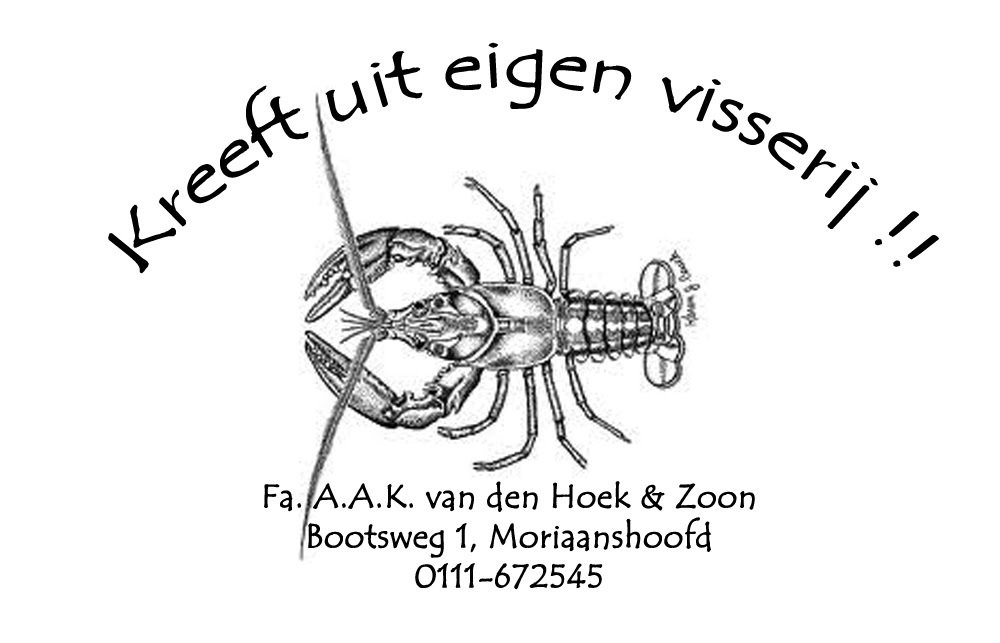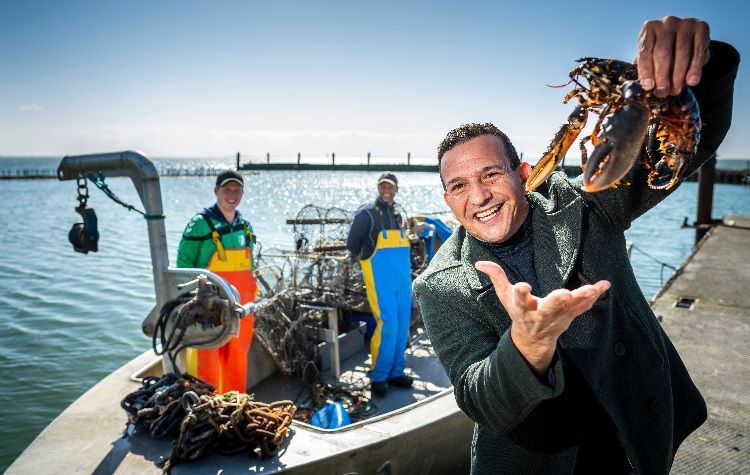Various fish species
Lobster
Oosterschelde lobster
The Oosterschelde lobster is a special and unique "product" from the Oosterschelde. Scientific research has shown that the Oosterschelde lobster has a finer and softer taste due to the different DNA structure compared to the other lobsters in the world.
Moreover, the freshness of the Oosterschelde lobster (directly from the Oosterschelde to the restaurants) guarantees a high-quality product. The Oosterschelde lobster is also characterized by the sustainable fishing method.
WHERE DOES THE OOSTERSCHELDT CREATE FROM?
Lobsters are not rare in European waters. Lobsters can be found from the Black Sea to the Lofoten in Norway. There is only one condition that Homarus gammarus, as the European lobster's scientific name is, imposes on its habitat: it must be rocky. Holes and crevices between the rocks provide shelter for the animal. There is no natural rocky coast in the Oosterschelde; the bottom of the estuary is largely sandy and silty. Only 150 years ago large amounts of stones in the estuary were used in the construction of dikes.
Fishermen knew and know the Oosterschelde well and were therefore surprised when in 1883 a lobster, the very first, was caught. Later, all catches were accurately recorded by the Board of Fisheries on the Zeeuwsche Stromen. This showed, among other things, that the lobster population, for example, almost disappeared after severe winters, only to slowly recover. The conclusion is inescapable: the Oosterschelde lobster is an immigrant. But where did "our" lobster originally come from?
In the Golden Age Zierikzee was the place from which just about all Norwegian lobsters were transported to the most important cities in Europe. The story goes that in the 18th century a ship carrying live Norwegian lobsters sank near Zierikzee. These animals escaped and these would be the ancestors of the Oosterschelde lobster.
This is a typical lobster roll story, many biologists believe. It sounds nice, they said, but it is far removed from biological reality. They point out that in their earliest childhood, when they hatch from the egg, lobsters swim around for a while as larvae. Only after about two weeks do they sink to the bottom, where the current has carried them.
Rocky bottoms occur in the North Sea near Norway and Sweden, as in the Pas de Calais between France and Great Britain. There are also shipwrecks and rocks from the Ice Age in the North Sea here and there; places where lobsters live. It is therefore very probable that lobster larvae can end up in Zeeland waters due to currents.
The Oosterschelde lobster was therefore undoubtedly once washed in from the North Sea as a larva and has reproduced there, in the Oosterschelde, rather, but not completely, in isolation. There is hardly any exchange of water from the Oosterschelde with the North Sea.
DNA research
Ultimately, it took European DNA research to provide some clarity about the Eastern Scheldt lobster. This research has shown that the tasty arthropod from the Oosterschelde has recognisably deviating DNA.
The history of the Oosterschelde lobster can now be outlined as follows. Before the closure of the Kreekrak between Zuid-Beveland and Brabant in 1868, larvae washed in from the North Sea could not continue to live, grow and reproduce because the salinity in the Oosterschelde fell sharply in winter. In winter, the fresh water of the river Scheldt ran for a large part through the Oosterschelde to the sea. After the closure, this no longer happened and the fresh water could only be discharged to the sea via the Western Scheldt. Thus began the build-up of the lobster population in the Oosterschelde from that time. In addition to water with a reduced salinity, lobsters cannot tolerate water with a very low temperature. So, once there were harsh winters for the past century and a half, the lobster population was decimated. During the construction of the Delta Works, many lobsters also died due to the mass of fresh water that flowed from the major rivers through the Oosterschelde to the North Sea.
That process, mortality due to low temperatures and low salinity, meant that the lobster population had to be built up again and again from a few very strong lobsters that had survived everything. Due to this strong genetic selection, only a few lobsters have contributed to the DNA of the current Oosterschelde lobster. Lobsters elsewhere in Europe have much more variation in their DNA. So there is a real difference and so the Oosterschelde got its own lobster!
Three method of lobster fishing (the sustainable fishing method)
The lobster can be found in various places in the Oosterschelde; only where there is a stony bottom. The lobster likes to hide there to get hold of its prey. Once his territory has been found, he himself is a sought-after prey for the lobster fisherman.
One way is with baskets. These baskets are made of plastic tube and network and are attached to a line of approximately 25 m every 2 m and secured in the dike with an anchor, provided with a bladder with the fish number. The baskets are baited with fish waste. They are lifted and rebaited every day.
The second way is with standing wall or warp yarn, this net is also made of plastic (nylon or perlon). It is approximately 80cm high and 100m long, with a lead string at the bottom and floats at the top. In between is a fine mesh net, in which the lobsters get stuck. This net is secured on two sides with anchors and provided with a joon and bladder with fish number. These nets can remain in place for several days and are taken on board by hand or power block.
The third way is with shooting traps, these traps are about 80cm high and equipped with a bulkhead of 5 meters long and a normal trap. They are attached to each other with 10 pieces, weighted and provided with two anchors with joon, bladder and fish number. These traps can also remain in place for several days and are brought on board by hand or roller.
edible crab
Categories:





